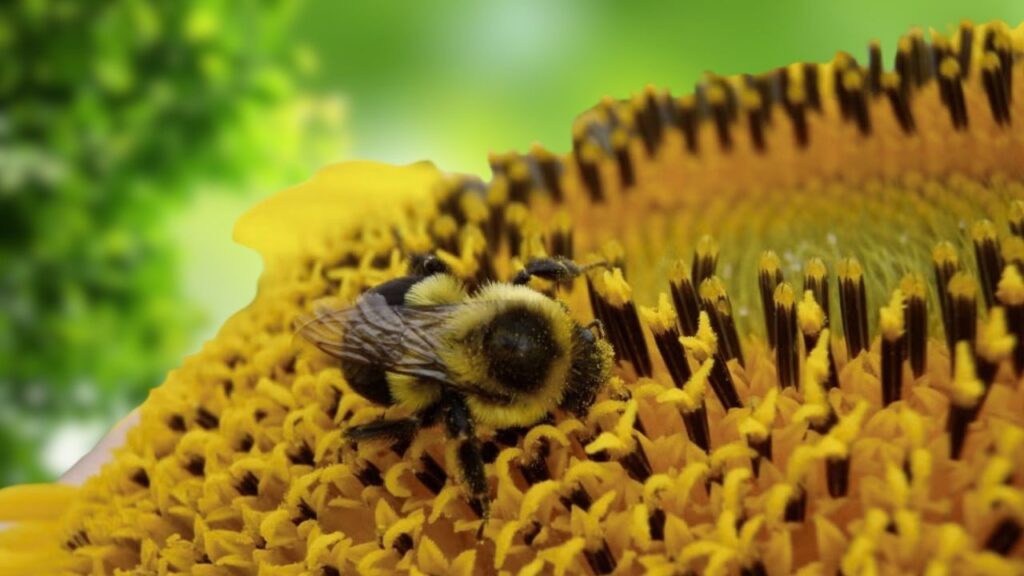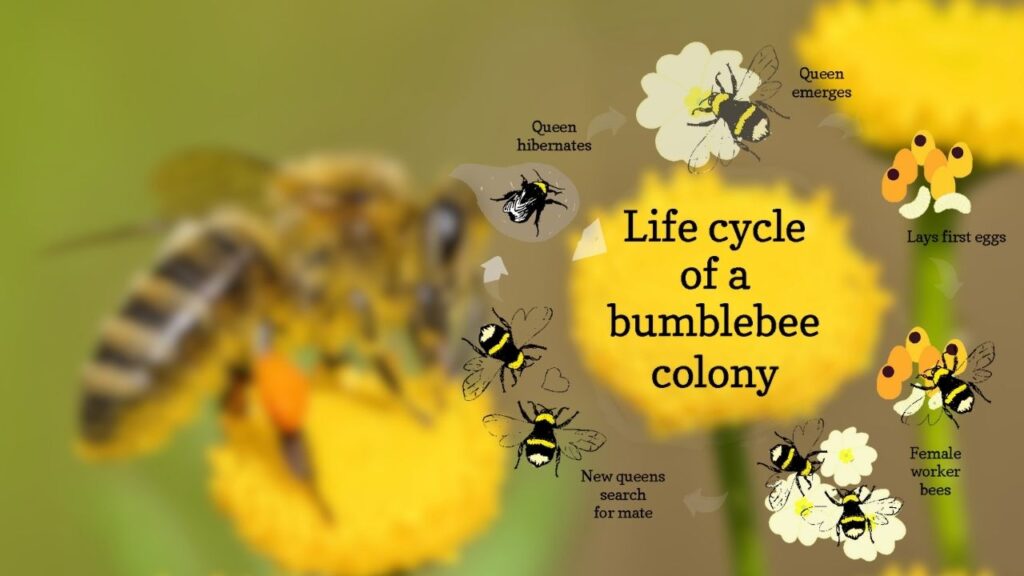Bumblebee Colony’s Secret Pause Strategy: Bumblebees are some of nature’s most fascinating and essential creatures. Their role as pollinators is critical for the growth of many crops and wild plants, making them a cornerstone of healthy ecosystems and food production.

For years, scientists believed bumblebee queens worked without rest, laying eggs continuously to build up their colonies as quickly as possible. However, a recent breakthrough has revealed a new and surprising behavior: bumblebee queens use a secret pause strategy, deliberately taking breaks from egg-laying. This discovery is changing how experts think about bee biology, colony survival, and conservation.
Bumblebee Colony’s Secret Pause Strategy
| Aspect | Details |
|---|---|
| Discovery | Bumblebee queens take strategic breaks from egg-laying, rather than working nonstop. |
| Why It Matters | These pauses help prevent queen exhaustion and improve colony survival during vulnerable early stages. |
| How It Works | Queens lay eggs in bursts, then pause for several days, resuming when brood matures or new brood is present. |
| Evidence | Laboratory studies observed over 100 queens; presence of pupae triggers egg-laying to restart in about 36 hours. |
| Conservation Impact | Understanding this strategy is vital for supporting declining bumblebee populations. |
| Lead Researcher | Blanca Peto, University of California, Riverside |
| Date Published | April 9, 2025 |
The discovery of the bumblebee queen’s secret pause strategy is a major leap forward in our understanding of these vital pollinators. By taking deliberate breaks from egg-laying, queens protect themselves and their colonies during the most vulnerable phase of their life cycle. This insight not only challenges old beliefs but also provides practical guidance for conservation, agriculture, and anyone who wants to help bumblebees thrive.
Supporting bumblebee queens—through thoughtful gardening, farming, and habitat management—can make a real difference. By working together, we can ensure a healthy future for bumblebees and the ecosystems that depend on them.
Understanding the Bumblebee Queen’s Pause Strategy

The Traditional View: Relentless Egg-Laying
For decades, it was widely accepted that bumblebee queens, after founding a nest, would lay eggs continuously. This made sense from a survival standpoint: the faster a colony could grow, the better its chances of thriving. The queen’s responsibilities are immense—she must forage for food, incubate her eggs, defend the nest, and care for her first batch of larvae, all on her own.
The New Discovery: Built-in Rest Periods
Recent research has upended this view. Scientists have now observed that bumblebee queens follow a rhythm of intense egg-laying followed by deliberate pauses. These rest periods can last several days and are not caused by stress, illness, or environmental hardship. Instead, they are a natural and adaptive part of the queen’s life cycle.
What Triggers the Pause?
The timing of these pauses is closely linked to the development of the queen’s brood. When the larvae or pupae are maturing, the queen slows down or stops egg-laying. If new pupae are introduced into the nest, the queen quickly resumes laying eggs—often within 36 hours. Without new brood to care for, queens have been observed to pause egg-laying for up to 12.5 days.
Why Is This Strategy Important?
- Energy Conservation: The solo phase is the most physically demanding period for the queen. By taking breaks, she conserves energy and reduces the risk of burnout.
- Colony Survival: If the queen exhausts herself before her first workers emerge, the colony is likely to fail. The pause strategy helps ensure she survives long enough for her offspring to take over essential tasks.
- Adaptive Advantage: This behavior is likely an evolutionary adaptation, maximizing the chances of colony success in unpredictable environments.
The Science Behind the Pause: How Researchers Discovered It
Observational Studies
To uncover this secret, researchers monitored over 100 bumblebee queens in controlled laboratory settings. They recorded the queens’ behaviors, egg-laying patterns, and responses to changes in brood composition. The data showed a consistent pattern: after a period of egg-laying, queens would take a break, only resuming when brood development signaled it was time.
Experimental Manipulation
To test the link between brood maturity and egg-laying, scientists introduced pupae into nests during a queen’s pause. The result was clear—queens with new pupae quickly restarted egg-laying, while those without could remain inactive for much longer. This demonstrates a sophisticated feedback system between the queen and her brood.
Not a Stress Response
Importantly, these pauses occurred even when queens had abundant food, ideal temperatures, and no predators. This means the behavior is not a reaction to hardship but a core feature of bumblebee biology.
Why This Discovery Matters
Conservation Implications
Bumblebee populations are declining worldwide due to habitat loss, pesticide exposure, and climate change. Understanding the queen’s pause strategy is essential for:
- Designing Effective Habitats: By knowing when queens need rest and resources, conservationists can better plan flower planting and habitat management.
- Supporting Colony Establishment: Providing safe nesting sites and continuous food sources during the queen’s solo phase can increase colony survival rates.
- Informing Policy and Practice: This knowledge can guide agricultural and environmental policies to better protect these vital pollinators.
Agricultural Impact
Bumblebees pollinate many crops, including tomatoes, berries, and peppers. Healthy colonies mean better crop yields and food security. Farmers can benefit from strategies that support queen survival and colony establishment, such as:
- Planting diverse, season-long flowering crops
- Reducing pesticide use during key nesting periods
- Maintaining wildflower strips and natural habitats near fields
Broader Scientific Significance
This discovery also prompts scientists to re-examine assumptions about other social insects. It suggests that dynamic reproductive strategies may be widespread, especially in species where the queen starts the colony alone.
Practical Guide: How You Can Help Bumblebee Queens and Colonies
1. Plant a Variety of Flowers
Choose native plants that bloom at different times throughout spring and summer. This ensures bumblebee queens always have access to nectar and pollen, especially during their solo phase.
2. Create Safe Nesting Spaces
Leave patches of undisturbed ground, tall grasses, or leaf litter in your garden or field. Avoid mowing or tilling these areas in early spring, when queens are searching for nest sites.
3. Avoid Pesticides
Chemicals can harm bumblebee queens directly or reduce their food supply. Use organic or bee-friendly pest control methods whenever possible.
4. Support Habitat Connectivity
Preserve hedgerows, wildflower corridors, and natural field edges. These features help queens find both food and nesting sites close together.
5. Participate in Citizen Science
Join local bumblebee monitoring programs. Your observations help scientists track bee populations and identify areas where conservation efforts are needed.
CO₂ to Methane Conversion Unlocked by Tweaking Nickel Nanoparticle Shape
Strange Memory Effect Found Controlling Quantum Atomic Motion on Metals
Bigger Molecules Now Proven to Extend Quantum Charge Flow Like Never Before
FAQs About Bumblebee Colony’s Secret Pause Strategy
Q1: Why do bumblebee queens pause egg-laying?
A: Queens take breaks to conserve energy and avoid exhaustion. This strategy helps them survive the demanding solo phase and ensures the colony’s success.
Q2: Does this pause strategy occur in all bumblebee species?
A: The pause strategy has been documented in a common North American species, but similar behaviors may exist in other species. More research is needed to confirm this.
Q3: How can gardeners support bumblebee queens?
A: Plant a range of native flowers, avoid pesticides, and leave some wild areas undisturbed. These steps provide food and safe nesting sites for queens.
Q4: Are bumblebees at risk?
A: Yes, many bumblebee species are declining due to habitat loss, pesticides, and climate change. Supporting queens is crucial for reversing these trends.
Q5: What can farmers do to help?
A: Maintain wildflower strips, reduce pesticide use, and provide nesting habitats near crops. These actions support healthy bumblebee populations and improve pollination.
Q6: How does the queen know when to resume egg-laying?
A: The queen responds to cues from her brood. When larvae or pupae mature, she receives signals to restart egg-laying, ensuring the colony grows at a sustainable pace.
Q7: Is the pause strategy unique to bumblebees?
A: While this behavior is newly documented in bumblebees, it may also occur in other social insects. Scientists are now exploring whether similar strategies exist in ants, wasps, and related species.
Real-World Example: A Year in the Life of a Bumblebee Queen
Imagine a queen bumblebee emerging from hibernation in early spring. She searches for a nest, often choosing an abandoned rodent burrow or a patch of tall grass. Once settled, she collects pollen and nectar to build her first brood. After laying a batch of eggs, she incubates them by shivering to generate heat, all while continuing to forage.
After several days of hard work, the queen pauses her egg-laying. During this break, she focuses on caring for her developing brood and regaining strength. When her first workers mature, they take over foraging and nest duties, allowing the queen to devote herself to laying eggs once again—this time, with the support of her colony.
This cycle of bursts and pauses continues, illustrating the remarkable adaptability and resilience of bumblebee queens.






